1993 CHEVROLET LUMINA tires
[x] Cancel search: tiresPage 230 of 324
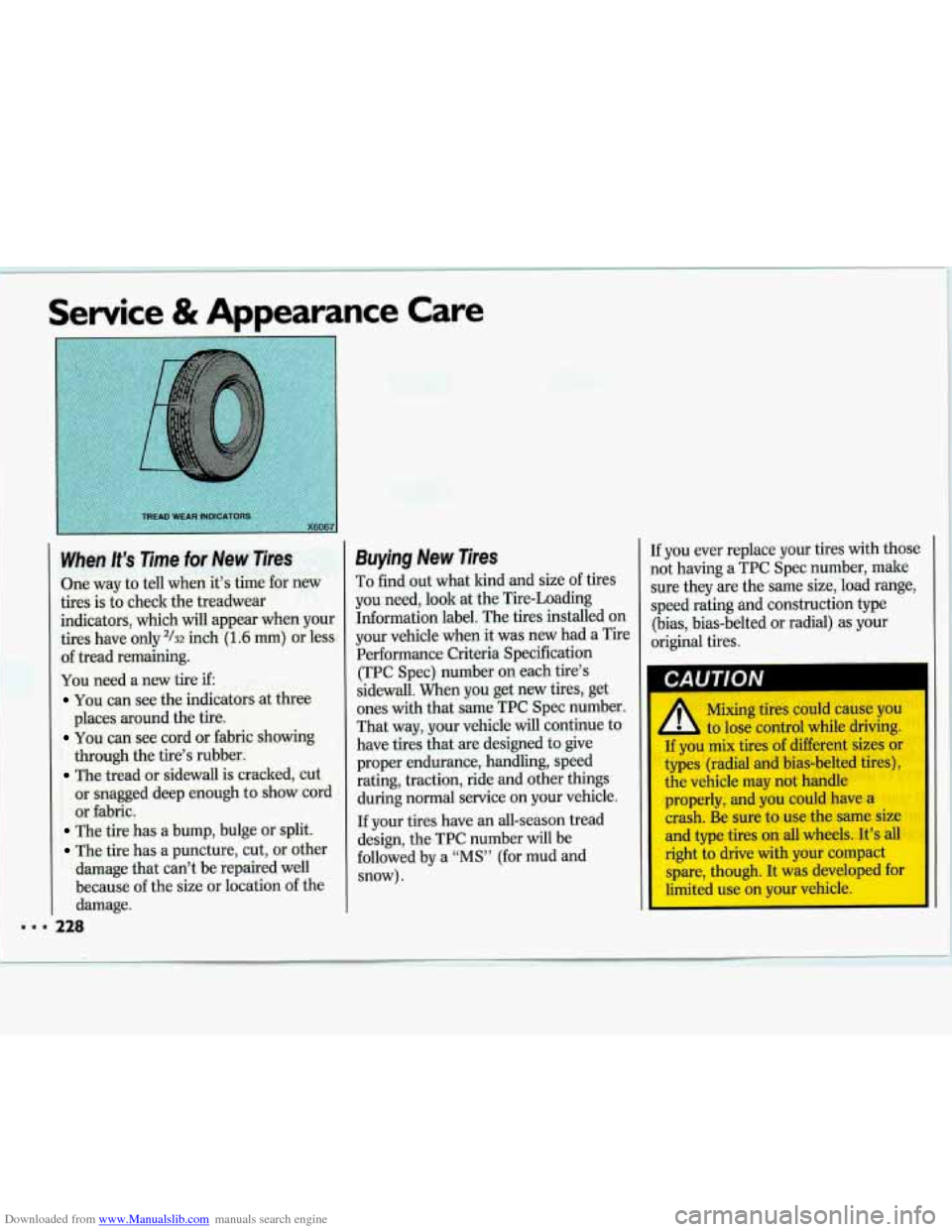
Downloaded from www.Manualslib.com manuals search engine Servi - - & f -- MI -- 3arance Care
When It’s Time for New Tires
One way to tell when it’s time for new
tires is to check the treadwear
indicators, which will appear when your
tires have only
2/32 inch (1.6 mm) or less
of tread remaining.
You need a new tire if:
You can see the indicators at three
You can see cord or fabric showing
The tread or sidewall is cracked, cut
places around
the tire.
through the tire’s rubber.
or snagged deep enough to show cord
or fabric.
The tire has a bump, bulge or split.
The tire has a puncture, cut, or other
damage that can’t be repaired well
because of the size or location of the
damage.
Buying New Tires
To find out what kind and size of tires
you need, look at the Tire-Loading
Information label. The tires installed on
your vehicle when it was new had a Tire
Performance Criteria Specification
(TPC Spec) number on each tire’s
sidewall. When you get new tires, get
ones with that same TPC Spec number.
That way, your vehicle will continue to
have tires that are designed to give
proper endurance, handling, speed
rating, traction, ride and other things
during normal service on your vehicle.
If your tires have an all-season tread
design, the TPC number will be
followed by a
“MS” (for mud and
snow). If
you ever replace your tires with those
not having a TPC Spec number, make sure they are the same size, load range,
speed rating and construction type (bias, bias-belted or radial) as your
original tires.
I CAUTION I
Mixing tires could cause you
to lose control while driving.
If you mix tires of different sizes or
types (radial and bias-belted tires)
,
the vehicle may not handle
properly, and you could have a crash. Be sure to use the same size
and type tires on all wheels. It’s all
right to drive with your compact
spare, though. It was developed for
limited use
on your vehicle.
Page 231 of 324
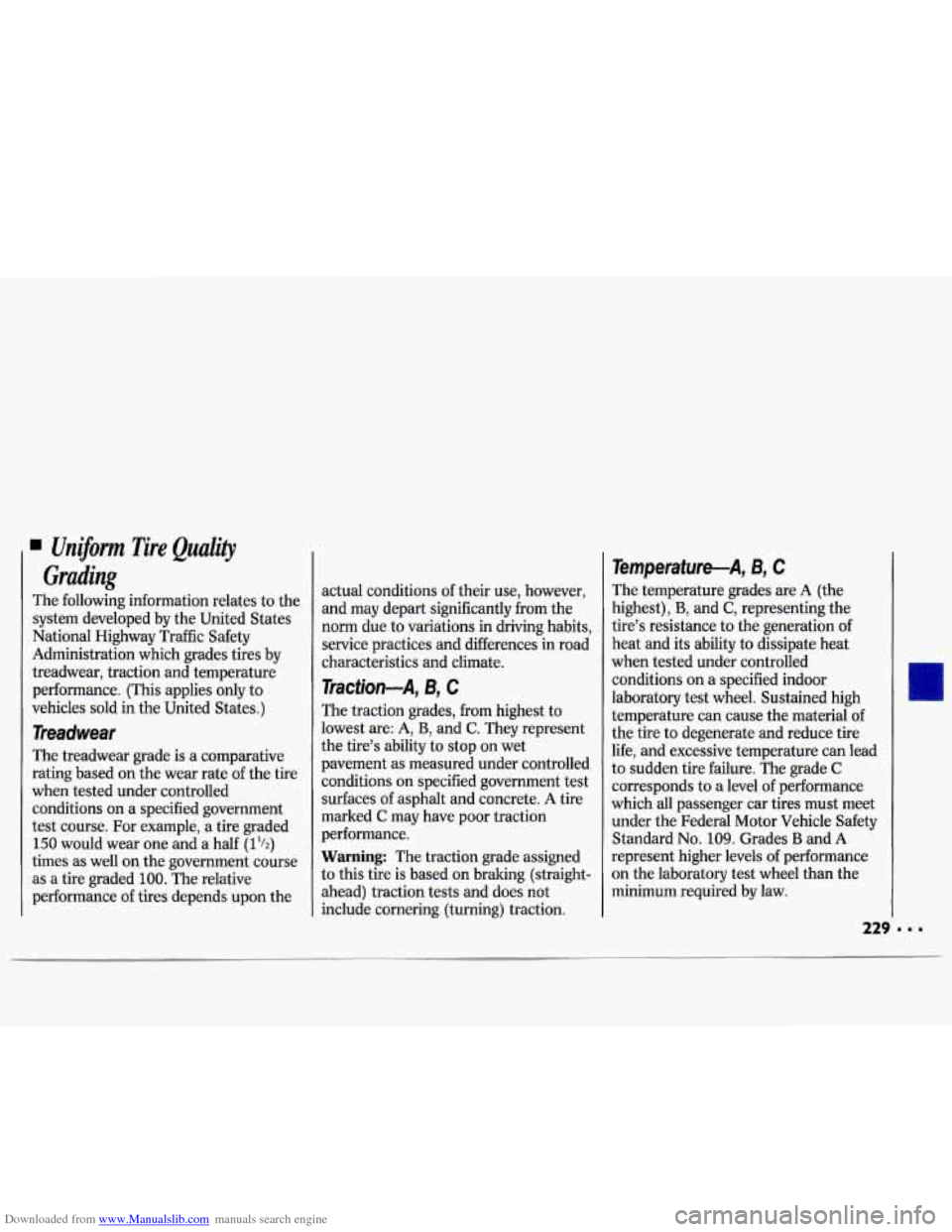
Downloaded from www.Manualslib.com manuals search engine Uniform Tire Quality
Grading
The following information relates to the
system developed by the United States
National Highway Traffic Safety
Administration which grades tires by
treadwear, traction and temperature
performance. (This applies only to
vehicles sold in the United States.)
The treadwear grade is
a comparative
rating based on the wear rate
of the tire
when tested under controlled
conditions on a specified government
test course. For example, a tire graded
150 would wear one and a half (1%)
times as well on the government course
as a tire graded
100. The relative
performance
of tires depends upon the
Treadwear
actual conditions of their use, however,
and may depart significantly
from the
norm due to variations in driving habits,
service practices and differences in road
characteristics and climate.
Traction-A, B, C
The traction grades, from highest to
lowest are: A,
B, and C. They represent
the tire’s ability to stop on wet
pavement as measured under controlled
conditions on specified government test
surfaces of asphalt and concrete. A tire
marked
C may have poor traction
performance.
Warning: The traction grade assigned
to this tire is based on braking (straight-
ahead) traction tests and does not
include cornering (turning) traction.
Temperature-A, B, C
The temperature grades are A (the
highest),
B, and C, representing the
tire’s resistance to the generation of
heat and its ability to dissipate heat
when tested under controlled
conditions on
a specified indoor
laboratory test wheel. Sustained high
temperature can cause the material of
the tire to degenerate and reduce tire
life, and excessive temperature can lead
to sudden tire failure. The grade
C
corresponds to a level of performance
which all passenger car tires must meet under the Federal Motor Vehicle Safety
Standard
No. 109. Grades B and A
represent higher levels of performance
on the laboratory test wheel than the
minimum required by law.
Page 232 of 324
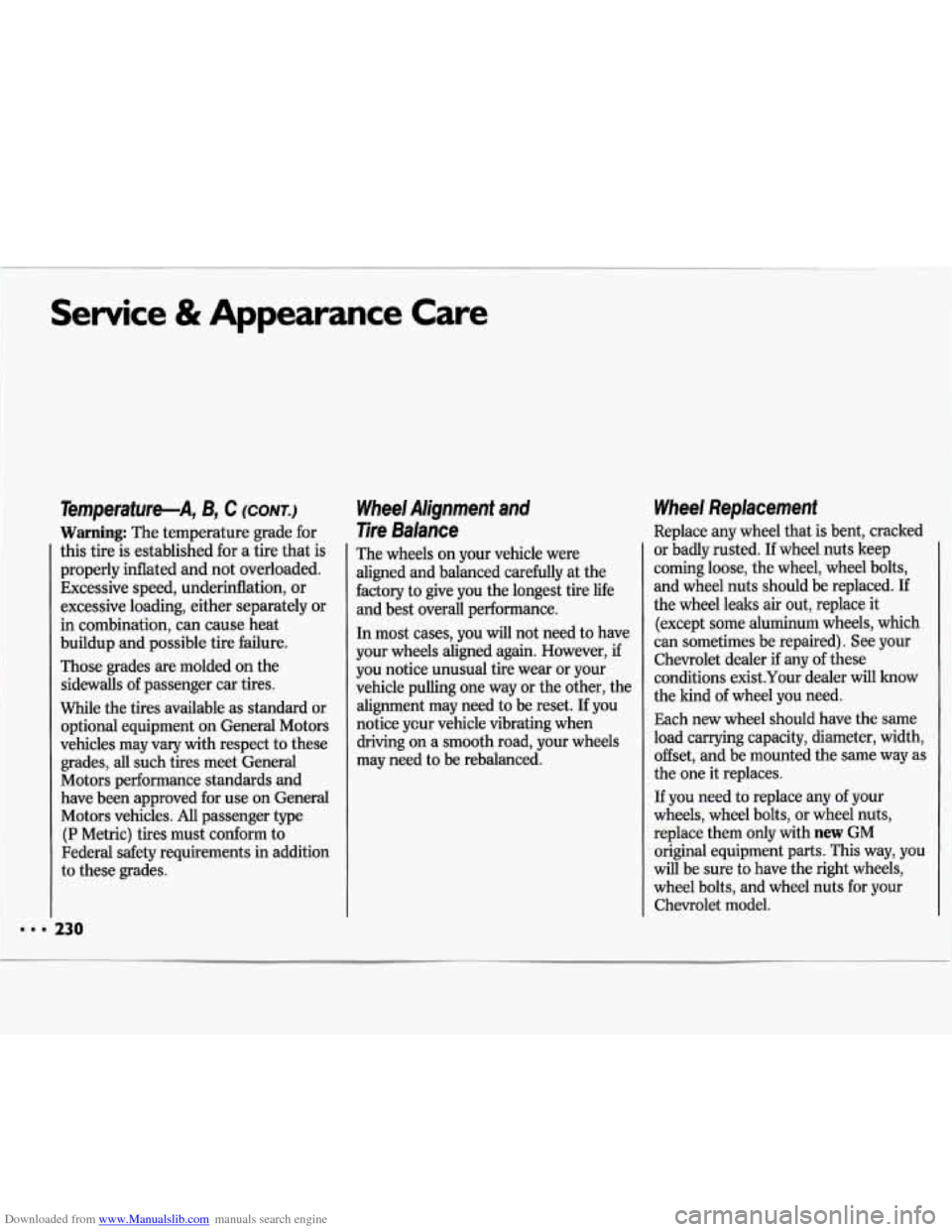
Downloaded from www.Manualslib.com manuals search engine Service & Appearance Care
Temperature-A, B, C (CONT.)
Warning: The temperature grade for
this tire is established for a tire that is
properly inflated and not overloaded.
Excessive speed, underinflation, or
excessive loading, either separately or
in combination, can cause heat
buildup and possible tire failure.
Those grades are molded on the
sidewalls of passenger car tires.
While the tires available as standard or
optional equipment on General Motors
vehicles may vary with respect to these
grades, all such tires meet General
Motors performance standards and
have been approved for use on General
Motors vehicles. All passenger type
(P Metric) tires must conform to
Federal safety requirements in addition
to these grades.
230
Wheel Alignment and
Tire Balance
The wheels on your vehicle were
aligned and balanced carefully at the
factory to give you the longest tire life
and best overall performance.
In most cases, you
will not need to have
your wheels aligned again. However, if
you notice unusual tire wear or your
vehicle pulling one way or the other, the
alignment may need to be reset. If you
notice ycur vehicle vibrating when
driving on a smooth road, your wheels
may need to be rebalanced.
Wheel Replacement
Replace any wheel that is bent, cracked
or badly rusted. If wheel nuts keep
I
coming loose, the wheel, wheel bolts,
and wheel nuts should be replaced. If
the wheel leaks air out, replace
it
(except some aluminum wheels, which
can sometimes be repaired). See your
Chevrolet dealer if any
of these
conditions exist.Your dealer will know
I
the kind of wheel you need.
Each new wheel should have the same
load carrying capacity, diameter, width,
offset, and be mounted the same way
as
the one it replaces.
If you need to replace any
of your
wheels, wheel bolts, or wheel nuts,
replace them only with
new GM
original equipment parts. This way, you
will be sure to have the right wheels,
wheel bolts, and wheel nuts for your
Chevrolet model.
Page 233 of 324
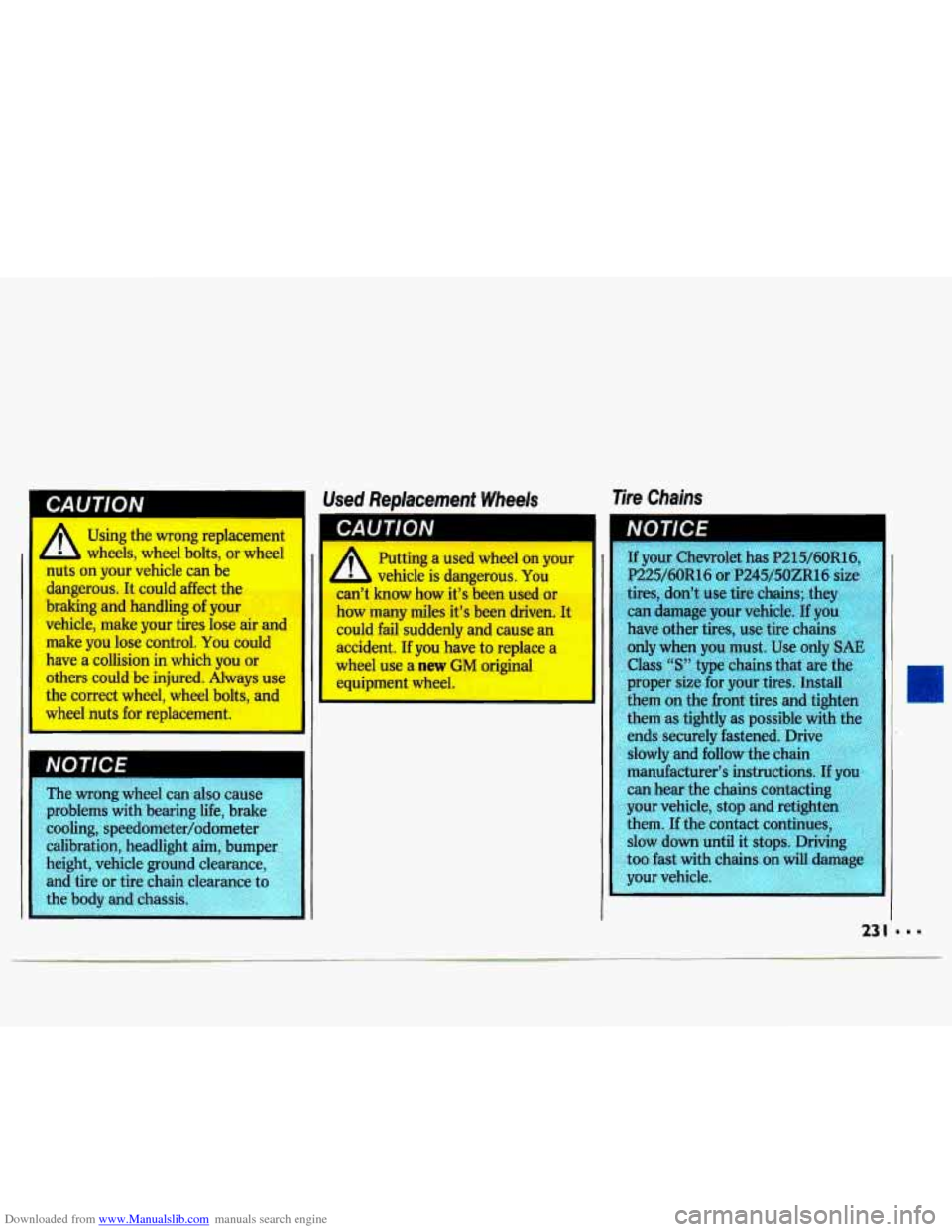
Downloaded from www.Manualslib.com manuals search engine A
Using the wrong replacement
wheels, wheel bolts, or wheel
nuts on your vehicle can be
dangerous. It could affect the
braking and handling
of your
vehicle, make your tires lose air and
make you lose control.
You could
have a collision in which you or
others could be injured. Always use
the correct wheel, wheel bolts, and
wheel nuts for replacement.
-
The wrong wheel can also cause
problems with bearing life, brake
cooling, speedometer/odorneter
calibration, headlight aim, bumper
height, vehicle ground clearance,
and tire or tire chain clearance
to
the body and chassis.
Used Replacement Wheels Tire Chains
Putting a used wheel on your
L vehicle is dangerous. You
can’t know how it’s been used or
how many miles it’s been driven. It could fail suddenly and cause an
accident. If you have to replace a
wheel use a
new GM original
L equiDment wheel.
the
I
’I
Page 239 of 324
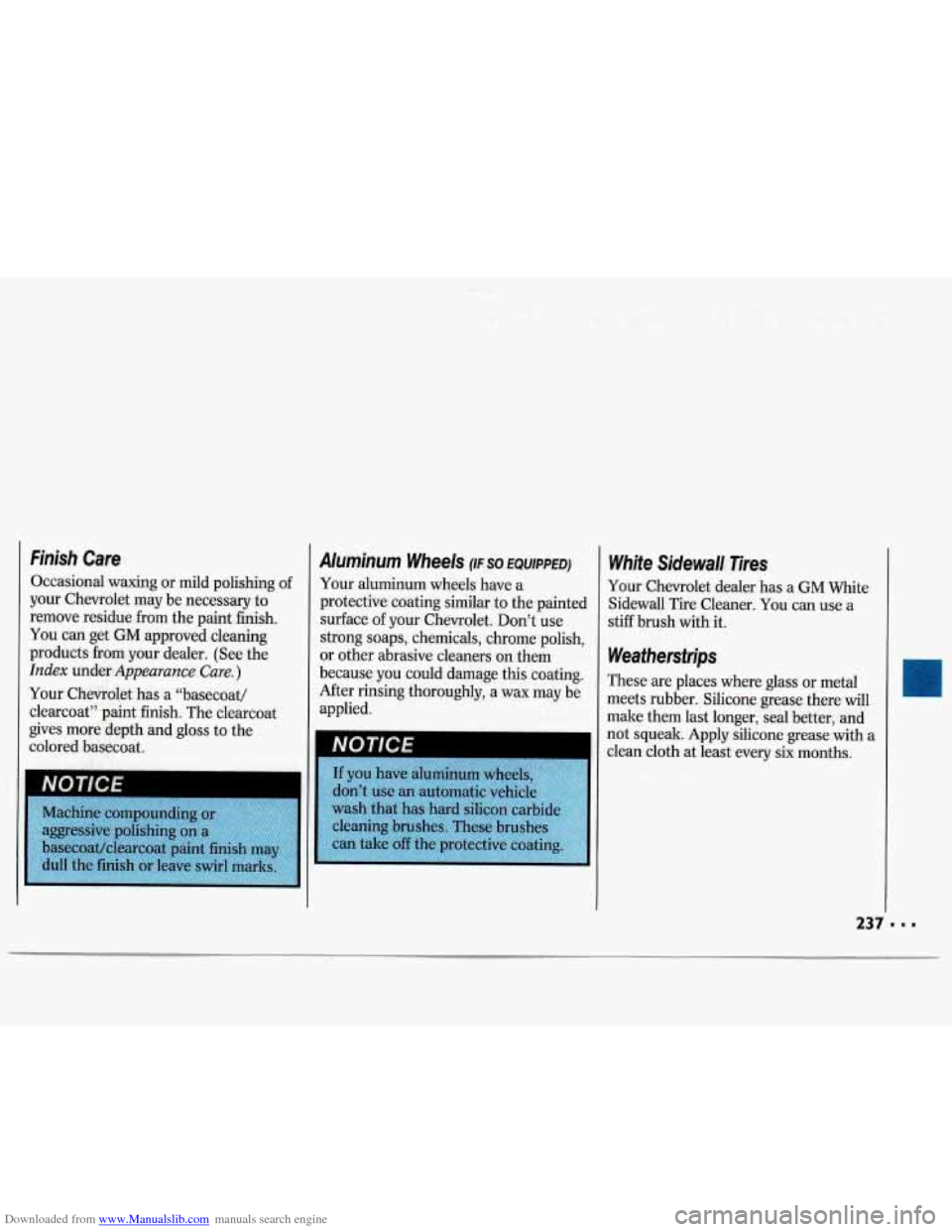
Downloaded from www.Manualslib.com manuals search engine Finish Care
Occasional waxing or mild polishing of
your Chevrolet may be necessary to
remove residue from the paint finish.
You can get
GM approved cleaning
products
from your dealer. (See the
Index under Appearance Care.)
Your Chevrolet has a “basecoat/
clearcoat” paint finish. The clearcoat
gives more depth and gloss to the
colored basecoat.
Aluminum Wheels (IF so EQuwmj
Your aluminum wheels have a
protective coating similar to the painted
surface
of your Chevrolet. Don’t use
strong soaps, chemicals, chrome polish,
or other abrasive cleaners
on them
because you could damage this coating.
After rinsing thoroughly, a wax may be
applied.
If you have aluminum wheels,
don’t use an automatic vehicle
wash that has hard silicon carbide
cleaning brushes. These brushes
can take
off the protective coatin
White Sidewall Tires
Your Chevrolet dealer has a GM White
Sidewall Tire Cleaner. You can use a
stiff brush with it.
Weatherstrips
These are places where glass or metal
meets rubber. Silicone grease there will
make them last longer, seal better, and
not squeak. Apply silicone grease with a
clean cloth at least every six months.
237 .
Page 270 of 324
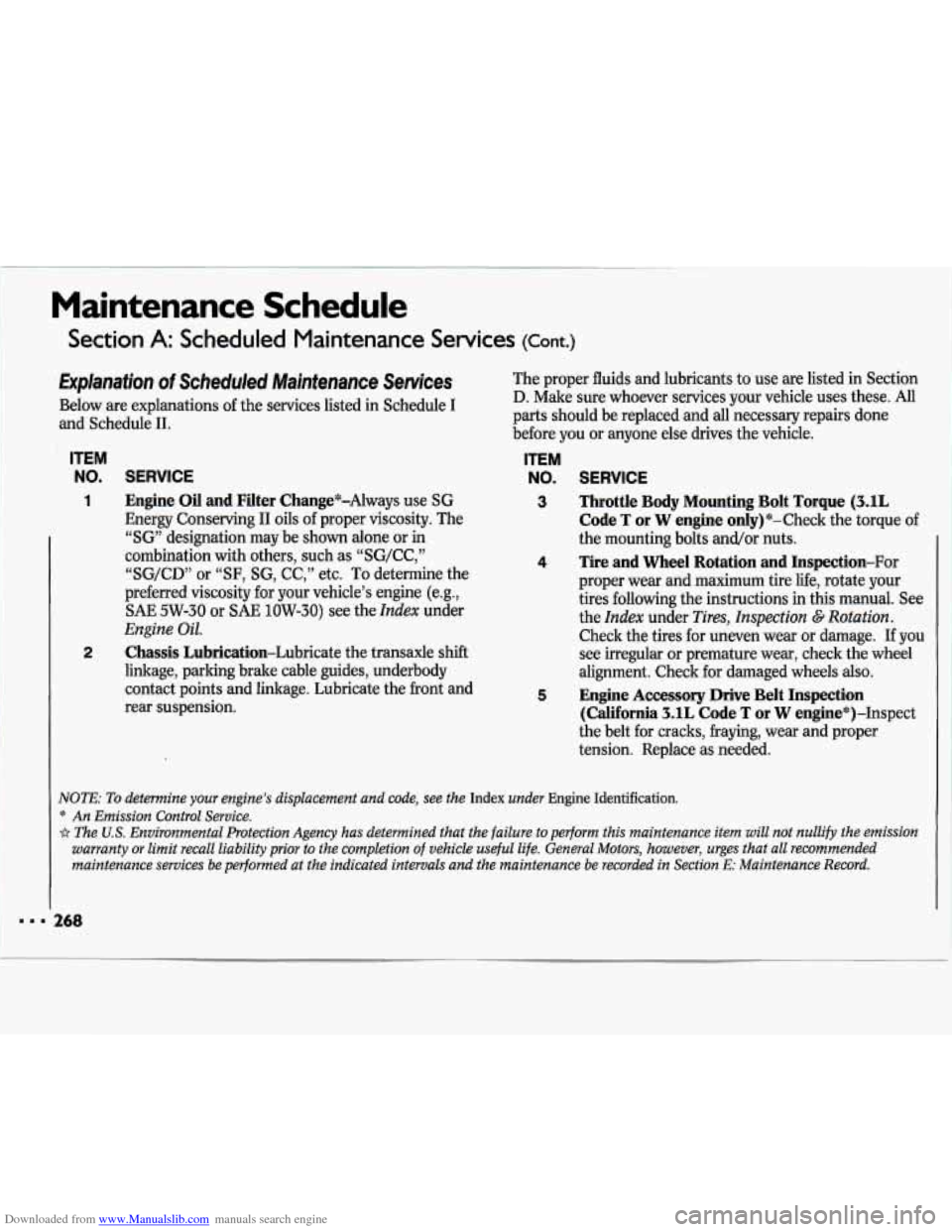
Downloaded from www.Manualslib.com manuals search engine Maintenance Schedule
Section A: Scheduled Maintenance Services (cont.)
Explanation of Scheduled Maintenance Services
Below are explanations of the services listed in Schedule I
and Schedule 11. The proper fluids and
lubricants to use are listed in Section
D. Make sure whoever services your vehicle uses these. All
parts should be replaced and all necessary repairs done
before you or anyone else drives the vehicle.
ITEM
NO.
1
2
SERVICE
Engine Oil and Filter Change*-Always use SG
Energy Conserving I1 oils of proper viscosity. The
“SG” designation may be shown alone or in
combination with others, such as “SG/CC,”
“SG/CD” or “SF, SG, CC,” etc. To determine the
preferred viscosity for your vehicle’s engine
(e.g.,
SAE 5W-30 or SAE 1OW-30) see the Index under
Engine Oil.
Chassis Lubrication-Lubricate the transaxle shift
linkage, parking brake cable guides, underbody contact points and linkage. Lubricate the front and
rear suspension.
ITEM
NO. SERVICE
3 Throttle Body Mounting Bolt Torque (3.1L
Code T or W engine only)*-Check the torque of
the mounting bolts and/or nuts.
4 Tire and Wheel Rotation and Inspection-For
proper wear and maximum tire life, rotate your
tires following the instructions in this manual. See
the
Index under Tires, Inspection G Rotation.
Check the tires for uneven wear or damage. If you
see irregular or premature wear, check the wheel
alignment. Check for damaged wheels also.
NOTE: To determine your engine’s displacement and code, see the Index under Engine Identification.
* An Emission Control Service.
* The US. Environmental Protection Agency has determined that the failure \
to perform this maintenance item will not nullify the emission
warranty
or limit recall liability prior to the completion of vehicle useful life. General Motors, however, urges that all recommended
maintenance services be performed at the indicated intervals and\
the maintenance be recorded in Section
E: Maintenance Record.
5 Engine Accessory Drive Belt Inspection
(California 3.1L Code T
or W engine*)-Inspect 1
the belt for cracks, fraying, wear and proper
tension. Replace as needed.
Page 273 of 324
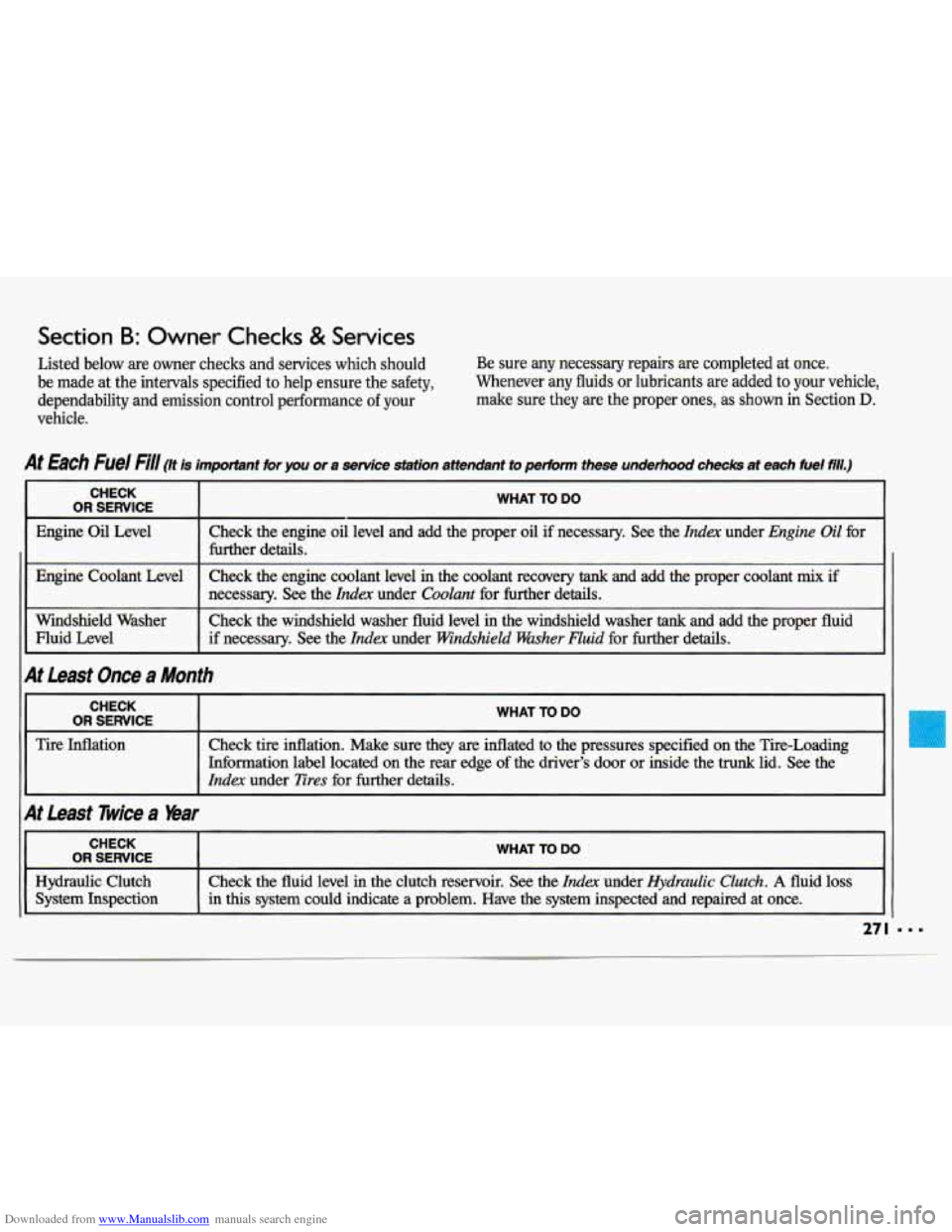
Downloaded from www.Manualslib.com manuals search engine Section B: Owner Checks & Services
Listed below are owner checks and services which should
be made at the intervals specified to help ensure the safety,
dependability and emission control performance of your
vehicle. Be
sure any necessary repairs are completed at once.
Whenever any fluids or lubricants are added to your vehicle,
make sure they are the proper ones, as
shown in Section D.
At Each he/ H// (It is important for you or a service station attendant to pe&m these underhood checks at each fuel fill.)
CHECK
I I Engine Coolant Level
I
Windshield Washer
Fluid Level
1 At Least Once a Month
WHAT TO DO
Check the engine oil level and add the proper oil if necessary. See the Index under Engine Oil for
further details.
Check the engine coolant level in the coolant recovery
tank and add the proper coolant mix if
necessary.
See the Index under Coolurzt for further details.
Check the windshield washer fluid level in the windshield washer tank and add the proper fluid
if necessary. See the Index under Windshield Washer Fluid for further details.
CHECK
I I OR SERVICE
Tire Inflation
I At Least Twice a bar
WHAT TO DO I
Check tire inflation. Make sure they are inflated to the pressures specified on the Tire-Loading
Information label located on the rear edge of the driver's door or inside the trunk lid.
See the
Inda under Tires for further details.
IL .I
CHECK
System Inspection
WHAT TO DO
Check the fluid level in the clutch reservoir. See the Iinda under Hydraulic Clutch. A fluid loss
in this system could indicate a problem. Have the system inspected and \
repaired at once.
27 I
Page 312 of 324

Downloaded from www.Manualslib.com manuals search engine 310
Braking in Emergencies ................... 131
“BreakIn,” New Vehicle
Braking Technique
........................... 126
Normal Driving
................................ 51
When Towing a Trailer .................. 155
Buckling Up (see
Safety Belts)
Bulb Replacement
Back-up Light
................................ 223
Center High-Mounted Stoplight
............................... 221, 251
Front Park and Turn Signal ........... 220
Front Sidemarker
........................... 221
Headlight
............................... 219, 251
Taillight
.................................. 222, 251
. C apacities and Specifications ....... 247
Carbon Monoxide in
Exhaust
............................... 67, 68, 153
Cassette Tape Player (see
Audio Systems)
Center Lap Belts (see Safety Belts)
Chains, Tire ............................ 187, 231
Changing a Flat Tire
......................... 181 Checking
Brake Fluid
.................................... 216
Engine Coolant
.............................. 173
Engine
Oil ...................................... 201
Hydraulic Clutch Fluid
.................. 210
Power Steering Fluid
..................... 214
Safety Belt Systems
.......................... 41
Things Under the Hood ................. 196
Transaxle Fluid Automatic
..................................... 206
Manual .......................................... 209
Child Restraints .................................. 30
Children ............................................. 29
Cigarette Lighter
................................ 82
Circuit Breakers
& Fuses ................ 241
City Driving ..................................... 143
Cleaner, Air
............................. 205, 254
Cleaning
Aluminum Wheels ......................... 237
Antenna
......................................... 114
Cassette Player and Tapes
............. 113
Compact Discs ............................... 114
Fabric .............................................. 233
Fiberglass Springs
........................... 239
Glass
............................................... 236
Inside of Your Chevrolet ................ 233 Outside
of Your Chevrolet
............. 236
Safety Belts
.................................... 235
Special Problems
........................... 234
Stains
.............................................. 234
Underbody Maintenance
............... 238
Vinyl or Leather
.............................. 235
Warnings ......................................... 232
Weatherstrips
................................. 237
White Sidewall Tires
..................... 237
Windshield and Wiper Blades
...... -236
Clock, Setting the
............................ 103
Clusters, Instrument Panel ............... 86
Clutch, Hydraulic
Adding Fluid
.......................... 210, 249
Checking Fluid
............................... 210
Air Conditioning
............................... 99
Heating .............................................. 98
Ventilation ...................................... 102
Compact Disc Player (see
Audio Systems)
Compact Spare Tire ......................... 187
Compartments, Storage ..................... 82
Console Storage Armrest
................... 82
Control of a Vehicle .......................... 125
Convenience Net ............................... 50
Comfort Controls